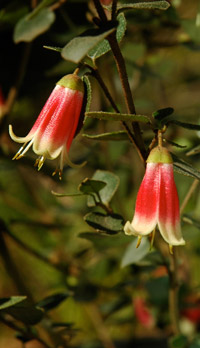Autumn 2012 - Issue 1
Winter 2012 - Issue 2
New ClimateWatch trail at the Australian National Botanic Gardens 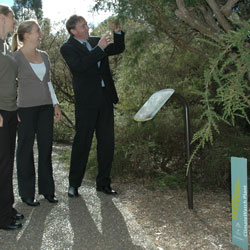
An exciting program allowing visitors to become ‘citizen scientists’ and monitor the effects of climate change on Australian native plants has been launched by the Australian National Botanic Gardens.
Developed in partnership with Earthwatch Australia, the ClimateWatch trail – located along the Gardens’ main path - allows visitors to take an active role in observing, monitoring and responding to the impacts of climate change.
“ClimateWatch empowers every Australian to become a citizen scientist by collecting and recording information about the natural world around them,” Andy Donnelly, the Acting Chief Executive Officer of Earthwatch Australia said. “This information will assist scientists and help shape the country’s scientific response to climate change.”
Gardens’ General Manager Peter Byron said he hoped the trail would inspire a new generation of young scientists.
“Visitors will be recording information such as flowering times and nesting patterns,” Mr Byron said.
“In a very practical way, they’ll be learning about the science of phenology – the study of periodic plant and animal life cycle events and how these are influenced by variations in climate.
“They’ll also be contributing valuable data to the national research effort to protect our native plants and animals.”
The ClimateWatch trail has been funded by the Friends of the Australian National Botanic Gardens, who are also supporting the initiative with volunteers to record observations and to help visitors to monitor flora and fauna.
“ClimateWatch provides community members such as schools with a focus for developing their understanding of climate change and natural processes. At the same time, scientists gain access to a suite of data collected in an efficient and cost-effective manner,” Mr Donnelly said.
Tour the Gardens in relaxing style on the Flora Explorer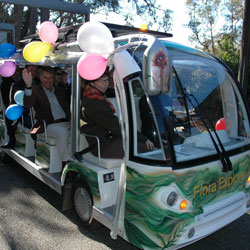
Visitors can now tour the Australian National Botanic Gardens in a relaxed style aboard the new Flora Explorer – a 12-seater electric passenger vehicle.
Funded and operated by the Friends of the Australian National Botanic Gardens, the Flora Explorer will take visitors on a one-hour guided journey, helping them discover some of the Gardens’ highlights including the Western Mallee, the Sydney Region Garden, the Eucalypt Lawn, the Rock Garden and Rainforest Gully.
The Gardens’ General Manager Peter Byron said he was excited to provide visitors another way of exploring these beautiful Gardens than just by foot.
“Not only can visitors to the Gardens walk along the many different walking tracks, but they can now experience the beauty and diversity of the Gardens by simply sitting back, relaxing and enjoying an interpreted tour of the Gardens,” he said.
“People of all ages – young and old – can easily experience more remote areas of the Gardens that they may never have seen before.”
“We are delighted to be supporting this fantastic new product at the Gardens,” Vice President of the Australian National Botanic Gardens, Barbara Podger said. “Our experienced volunteer drivers are sure to treat visitors to a fun, engaging and informative tour of the Gardens.”
The Gardens light up a cold winter’s night 
Bring new light to a winter’s night with the Australian National Botanic Gardens’ new afterDARK Firefly Tours [read more].
Image caption: See the Rainforest Gully come to life during the afterDARK Firefly Tours on the first Saturday of each month. Image courtesy of Lushpup Images.
Endangered pea goes home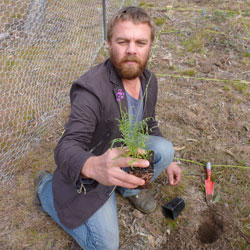
In partnership with ACTEW, around 70 plants of the endangered small purple pea (Swainsona recta) were planted in the ACT following a successful propagation program delivered by the Australian National Botanic Gardens.
The partnership to protect the small purple pea was established after ecological assessments found specimens near the pipeline route for ACTEW’s Murrumbidgee to Googong Water Transfer near Williamsdale.
While the pipeline was micro-aligned to ensure no plants would be disturbed, ACTEW was keen to play an active role in protecting the beautiful and nationally endangered plant.
“The pipeline raised our awareness of the small purple pea in the ACT and with the help of the Australian National Botanic Gardens, we have been able to contribute to ensuring its survival into the future,” ACTEW Managing Director, Mark Sullivan said.
Curator of Living Collections at the Australian National Botanic Gardens David Taylor says the success of the program has been a result of the combined expertise from the Gardens, ACTEW and other conservation agencies.
“This species is very difficult to propagate but our expert staff were able to collect the tiny seeds from the field, germinate them in our seed bank laboratory and then grow them in our specialist nursery facilities.”
“We have also drawn on the expertise of other conservation agencies to set up the planting for future research - turning an 18 month project in to something that can have ongoing outcomes.”
The specimens of the small purple pea are planted on the 110 hectare site established by ACTEW to offset the construction of the Murrumbidgee to Googong Water Transfer in perpetuity.
Planting the seedlings here ensures they will be monitored and managed carefully to give them the best chance of survival.
Not only can people see a small purple pea in the wild, they can also see the plant on display in the Grassy Woodland Garden at the Australian National Botanic Gardens.
Australian Seed Bank Partnership 1000 Species Project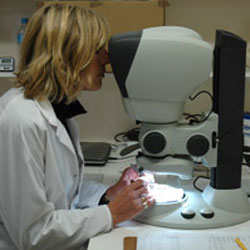
The 1000 Species Project is a national seed collecting initiative and a key project of the Australian Seed Bank Partnership(ASBP) – which is developing a national network of conservation seed banks. The project aims to collect and bank seed from 1000 native plant species as an insurance policy against current and emerging threats such as climate change.
The focus of the 1000 Species Project will be on plants whose seeds are not currently stored in national seed banks or at the Millennium Seed Bank in the UK, and the collections will target species which are endemic, endangered or have economic value. Partners of the ASBP will be actively involved in the collection and storing of native seed including seed research, which will ultimately contribute to the long term survival of Australia’s native flora.
To kick start this project, the ASBP has received generous financial support from the Royal Botanic Gardens Kew in the UK, this will assist ASBP partners during the collection phase. It is anticipated that funds will be available to interested Partners to support seed collecting in the upcoming season late in 2012. The ASBP secretariat is hosted at the Australian National Botanic Gardens.
![Director of National Parks [logo]](../../../images/dnp_90px.gif)





